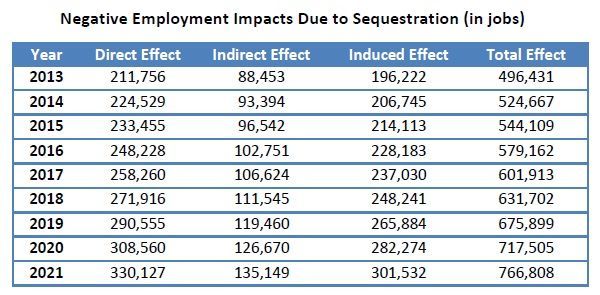Article
766,000 Jobs on the Line from Sequester of Medicare Spending
Author(s):
Hundreds of thousands of jobs will be lost as a result of the 2% sequester of Medicare spending. Here are the top 10 employment sectors most adversely affected from the cut.
More than 750,000 health care and related jobs could be lost in the next decade because of a mandated 2% sequester of Medicare spending, according to a new report. This number is significantly up compared to a 277,800 estimate in January 2012.
The Budget Control Act of 2011 mandated this sequester of Medicare spending from 2013 to 2021 in order to help reduce the deficit. The cuts — growing from $10.7 billion in 2013 to $16.4 billion in 2021—will be accomplished by reducing payments for health care services, according to a report by the American Hospital Association (AHA), the American Medical Association (AMA) and the American Nurses Association.
"Coupled with the looming 27% Medicare physician payment cut, this 2% sequester will hurt patient access to care and will inject more uncertainty into our Medicare system,” AMA President Jeremy A. Lazarus, MD, said in a statement.
According to the report, almost half a million jobs will be lost in the first year of this sequester and by 2021 there will be 766,000 fewer jobs. Only 330,127 of the more than a quarter million jobs lost will be direct employment, meaning those jobs directly paid by recipients of the funding dollars.
"Hospitals' ability to maintain the kind of access to services that their communities need is being threatened," AHA President and Chief Executive Officer Rich Umbdenstock said in a statement. "Cuts to hospital services could create devastating job losses in communities where hospitals have long been an economic mainstay."

Direct includes all direct effects the funded organizations have on the nation due to direct Medicare funding. Indirect is the impact of local industries buying goods and services from other local industries. Induced reflects the re-spending of income.
The states that will be most adversely affected by job losses by 2021 because of the cut are California with 78,444 jobs; Florida with 55,340 jobs; Texas with 49,695 jobs; New York with 49,121 jobs; and Pennsylvania with 37,382 jobs lost.
The cut, and resulting job losses, are unfortunate since right now the health care sector represents nearly 18% of the U.S. economy and “currently is one of the few bright spots in terms of job growth,” according to the report.
While six of the top 10 employment segments impacted by the cuts are health care related, there are other sectors that will also be affected by this sequester. The employment number represents jobs.
10. Insurance carriers
Negative employment (2013): 7,472
Negative employment (2021): 11,444
9. Wholesale trade business
Negative employment (2013): 8,424
Negative employment (2021): 12,965
8. Employment services
Negative employment (2013): 15,356
Negative employment (2021): 23,498
7. Food services and drinking places
Negative employment (2013): 21,865
Negative employment (2021): 33,612
6. Real estate establishments
Negative employment (2013): 22,705
Negative employment (2021): 35,040
5. Home health care services
Negative employment (2013): 25,547
Negative employment (2021): 39,143
4. Medical and diagnostic labs; outpatient and other ambulatory care services
Negative employment (2013): 38,350
Negative employment (2021): 56,527
3. Nursing and residential care facilities
Negative employment (2013): 38,115
Negative employment (2021): 61,809
2. Offices of physicians, dentists and other health practitioners
Negative employment (2013): 40,220
Negative employment (2021): 63,946
1. Hospitals
Negative employment (2013): 92,984
Negative employment (2021): 144,006




